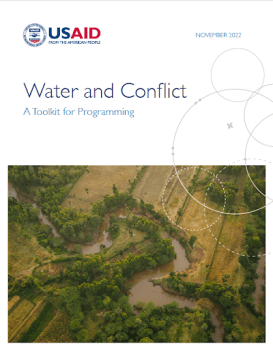USAID has released its recently revised Water and Conflict Toolkit, first published in 2014. As of 2015, 177 million people lacked basic drinking water and 284 million people did not use basic sanitation in conflict-affected settings. In the face of increasing and protracted conflict and crises around the world, USAID strives to lead and influence development programming to move beyond conventional water, sanitation, and hygiene (WASH) service provision to advance water security, sanitation, and hygiene (WSSH) in fragile and conflict-affected settings. This practical toolkit provides guidance for implementing partners, USAID staff, and other stakeholders who support the Global Water Strategy and White House Action Plan on Global Security to better understand the connection between water management and key risk factors associated with conflict, address those links, and incorporate conflict integration into water security, sanitation, and hygiene programming. The toolkit is one of a series of forthcoming USAID resources around conflict, including land, Feed the Future, food systems, and conflict integration.
This document discusses the importance of water management in conflict prevention and peacebuilding, particularly in fragile and conflict-affected settings. The toolkit provides guidance for implementing partners and USAID staff on how to incorporate conflict integration into water security, sanitation, and hygiene (WSSH) programming, with a focus on understanding the context, interactions between interventions and context/group relations, and avoiding negative impacts while maximizing positive impacts. The toolkit is divided into four parts: relationships between water management and conflict, cross-cutting sector considerations, best practices and program strategies, and a conflict analysis guide for water programming.
Introduction
Water is fundamental and irreplaceable to life, from supporting basic sanitation and preventing disease, to sustaining ecosystems and undergirding economies. Due to water’s centrality to other key sectors, water management must balance different interests from many stakeholders—from farmers and herders competing over shared water, to countries vying to control river water for irrigation and hydropower.
Where access to water in sufficient quantity and quality is limited, competition risks triggering or exacerbating conflict within countries. Even when water is not directly connected to the conflict, water insecurity interacts with underlying political, socioeconomic, institutional, and cultural factors to increase conflict risks. However, when managed effectively and cooperatively, water serves as a critical pathway for conflict prevention and peacebuilding.
To achieve Sustainable Development Goal 6 (SDG 6)—universal access to clean water and sanitation for everyone by 2030—development programming must move beyond conventional water sanitation and hygiene (WASH) service provision to advancing water security, sanitation, and hygiene (WSSH) in fragile and conflict-affected settings.
Of the 466 million people estimated to be living in conflict-affected states in 2015, 177 million (roughly 38 percent) lacked basic drinking water and 284 million (about 61 percent) did not use basic sanitation (WHO and UNICEF 2017). Expanding WSSH objectives requires programs to account for ecosystem health, climate change response, food security, energy development, livelihoods, and resilience.
It entails moving away from viewing water exclusively as an entry point to conflict resolution. Instead, water programming should consider how WASH services operate in conflict-affected contexts, incorporate sectoral considerations, mainstream climate and ecological considerations, advance participation of women and marginalized groups, and examine WASH services and management in the context of socio-economic and political factors.
Objectives
This practical toolkit explains the connection between water management and key risk factors associated with conflict, provides avenues for addressing those links, and suggests ways to incorporate conflict integration into WSSH programming. Its primary audience is implementing partners for water programming and USAID staff or other stakeholders who work to advance the whole-of-government White House Water Security Action Plan, the U.S. Government Global Water Strategy, and the associated USAID Agency Plan.
While the toolkit is intended to guide design, implementation, and monitoring, evaluation, and learning (MEL) across all USAID WSSH programming, it is particularly relevant for programs that fall under Strategic Objective 4 of the 2022 Global Water Strategy: Anticipate and reduce conflict and fragility related to water.
Toolkit Structure
This toolkit is intended to serve as a resource for any organization working on issues related to WSSH to become more sensitive to conflict intersections with water programming, specifically in their ability to:
- Understand the context in which it is operating, particularly with respect to inter-group relations;
- Understand the interactions between its interventions and the context/group relations; and
- Act upon these understandings in a way that avoids negative impacts and maximizes positive impacts.
This toolkit is divided into four parts:
- Relationships between water management and conflict, cooperation, and peacebuilding
- Cross-cutting sector considerations that show the interconnections between water management and other sectors
- Best practices and program strategies from USAID WSSH programming to help design stronger and more conflict-sensitive interventions
- Conflict analysis guide for water programming with key steps and resources to help practitioners follow a structured process to identify and evaluate conflict risks and interventions throughout the USAID program cycle.
This toolkit should be used alongside other resources that address conflict integration. It is one of a series of forthcoming USAID resources that apply conflict integration to specific USAID sectors, including:
- Land and Conflict Toolkit
- Feed the Future Conflict Toolkit
- Food Systems Conceptual Framework Companion Guide
- Conflict Integration Guide

You must be logged in in order to leave a comment